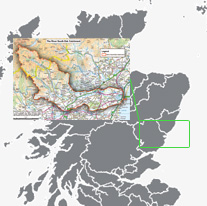Cultural history
The catchment has a great deal of cultural history. The town of Montrose dates back to about 1140, when the natural harbour and rich agricultural areas allowed Montrose to flourish as a port.
Early exports from the area were skins, hides and cured salmon. From the 17th century exports of wheat and malted barley became important while timber and flax were imported from the Baltic and wines, fruit and salt were imported from France and Portugal.
The town of Brechin, upstream of Montrose, also has connections to the river being built on a hill sloping gently back from the river. By the middle of the 19th century, Brechin had a paper mill, two flax mills, five linen factories, two bleachfields, two distilleries, a brewery, two saw mills and two nurseries, all of which needed water.
There are also several historical buildings connected with the river in the area.Inverquharity Castle, just north of Kirriemuir, was home to the Ogilvies from 1420. It takes its name from the Quharity Burn, which joins the main river by the castle.

Further up is Cortachy Castle, the family home of the Earl of Airlie. Airlie Estates is one of the many landowners in the area who manage the land for conservation purposes, and for shooting and fishing. Near Cortachy lies Burnside Cottage, now Burnside Lodge, where Dr Wilson, who accompanied Captain Robert Scott on his Antarctic expedition in 1912, wrote his definitive work on diseases of grouse.
Just up river is the Doulin Haugh mill lade, one of several former lades – (man-made channels) that fed water to sawmills and watermills for grinding grain and processing cloth.
Half a mile along the road from Dykehead lies the hamlet of Cullow, where a cattle and sheep fair used to be held. In the 1840s between 8000 and 12,000 sheep were brought in, over Jock’s Road, to the head of the White Water and over Capel Mounth to the South Esk, to sell at Cullow in April and October.
In those days the population of the parish was much bigger. In 1755 Cortachy and Clova had 1233 inhabitants, and in the 1790s the area supported three smiths, four carpenters, three millers, three shopkeepers and 10 sellers of strong drink. Today the population has fallen to around 380. The Minister's Path, which links Glen Clova and Glen Prosen takes its name from the fact that the Manse in Clova served both the Glen Clova and Glen Prosen churches, and this is the route theminister would regularly take.

© Copyright Lis Burke. Creative Commons Licence
In the early 19th century there was a commercial fresh-water pearl fishery at Gella Bridge. At Milton of Clova, beside the Clova Hotel stands a partially restored meal mill. From Milton of Clova, a single track road runs a further three miles up the glen, passing what is left of Clova Castle – just the stump of a tower on a low hill. At the end of the public road lies, on the west, the entrance to Glen Doll and on the east, the Capel Mounth. This old drove road from Glen Clova to Glen Muick was surveyed in the 1830s with the aim of improving it into a proper road to encourage trade.
However, the plan was dropped in favour of a road through Glen Shee.


